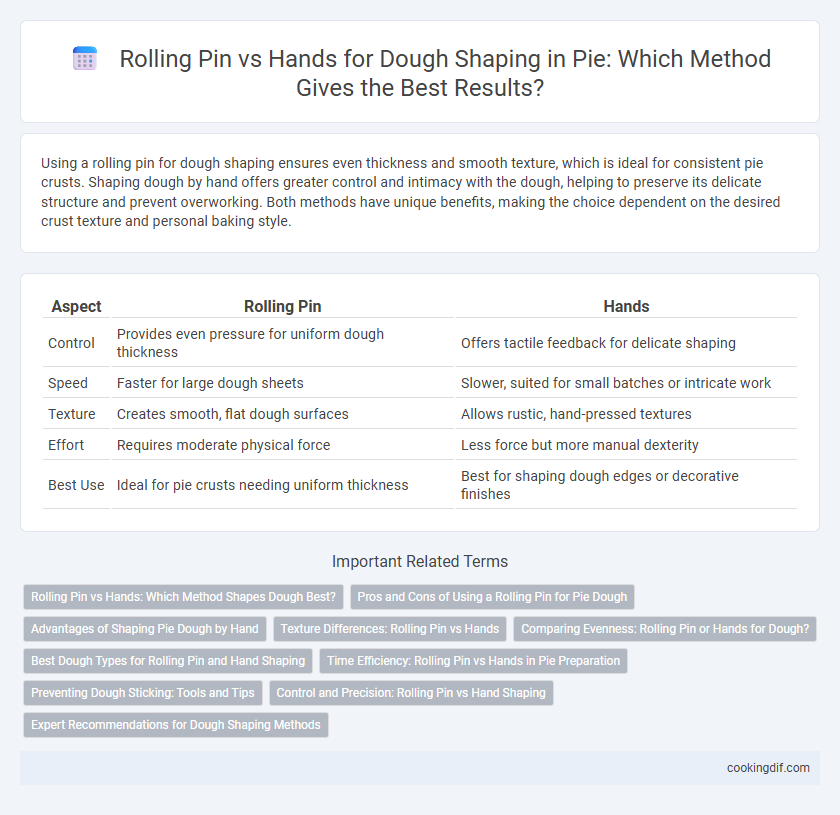Using a rolling pin for dough shaping ensures even thickness and smooth texture, which is ideal for consistent pie crusts. Shaping dough by hand offers greater control and intimacy with the dough, helping to preserve its delicate structure and prevent overworking. Both methods have unique benefits, making the choice dependent on the desired crust texture and personal baking style.
Table of Comparison
| Aspect | Rolling Pin | Hands |
|---|---|---|
| Control | Provides even pressure for uniform dough thickness | Offers tactile feedback for delicate shaping |
| Speed | Faster for large dough sheets | Slower, suited for small batches or intricate work |
| Texture | Creates smooth, flat dough surfaces | Allows rustic, hand-pressed textures |
| Effort | Requires moderate physical force | Less force but more manual dexterity |
| Best Use | Ideal for pie crusts needing uniform thickness | Best for shaping dough edges or decorative finishes |
Rolling Pin vs Hands: Which Method Shapes Dough Best?
Using a rolling pin ensures even thickness and smooth surface for pie dough, promoting consistent baking results and a flaky crust. Shaping dough by hand provides better control over thickness variations and preserves air pockets, enhancing dough texture and preventing overworking. Professional bakers often combine both methods to optimize dough elasticity and achieve ideal pie crust structure.
Pros and Cons of Using a Rolling Pin for Pie Dough
Using a rolling pin for pie dough ensures even thickness and smooth surface, which promotes uniform baking and a professional appearance. However, it can lead to overworking the dough, resulting in a tougher crust if not handled carefully. In contrast, shaping by hand offers greater control over texture but may cause uneven thickness and inconsistent baking.
Advantages of Shaping Pie Dough by Hand
Shaping pie dough by hand allows for greater control over thickness and texture, ensuring a flakier crust with a more artisanal appearance. Hands provide tactile feedback to prevent overworking the dough, preserving its delicate gluten structure which results in a tender, melt-in-your-mouth finish. This method also enables easy adjustment of dough edges for decorative crimping and a rustic look, enhancing both presentation and baking performance.
Texture Differences: Rolling Pin vs Hands
Using a rolling pin for pie dough typically results in a uniform, thinner crust with a smooth texture, ideal for even baking and crispness. Shaping dough by hand preserves more air pockets and creates a slightly thicker, flakier crust, enhancing tenderness and a rustic appearance. Texture differences between rolling pin and hand-shaped dough influence the final pie's mouthfeel, with rolling providing consistency and hands offering artisanal variability.
Comparing Evenness: Rolling Pin or Hands for Dough?
Using a rolling pin ensures more consistent dough thickness, resulting in evenly baked pie crusts with a uniform texture. Shaping dough by hand offers greater control over thickness variations but may lead to uneven spots that affect baking performance. For precise, even dough, a rolling pin outperforms hand shaping in achieving balanced crust thickness and optimal pie quality.
Best Dough Types for Rolling Pin and Hand Shaping
Rolling pins excel at shaping firm doughs like pie crusts made from butter or shortening, providing even pressure for uniform thickness. Hand shaping works best for soft, sticky doughs such as enriched or gluten-free varieties, allowing more control to maintain their delicate texture. Optimal results depend on dough consistency, with rolling pins preferred for sturdier doughs and hands favored for pliable, sensitive mixtures.
Time Efficiency: Rolling Pin vs Hands in Pie Preparation
Using a rolling pin for pie dough shaping significantly reduces preparation time by ensuring uniform thickness quickly, compared to manually stretching the dough with hands. Hands-on shaping may offer more control over dough texture but often requires extra effort and longer handling time to achieve the desired shape. For time-efficient pie preparation, a rolling pin optimizes consistency and speed without compromising dough quality.
Preventing Dough Sticking: Tools and Tips
Using a rolling pin coated with flour prevents dough from sticking by creating a dry barrier between the dough and the surface, ensuring smooth and even shaping. Hand shaping involves frequently dusting both hands and dough with flour to minimize adhesion while maintaining control over thickness and texture. Selecting a wooden or silicone rolling pin also reduces sticking compared to metal, while using a lightly floured silicone mat can further prevent dough adherence during rolling.
Control and Precision: Rolling Pin vs Hand Shaping
Using a rolling pin for dough shaping provides consistent thickness and uniformity, enhancing control over the final crust texture. Hand shaping allows for more precise adjustments around edges and corners, giving better control in creating rustic or decorative finishes. Combining both methods optimizes the dough's elasticity and precision, resulting in a perfectly shaped pie crust.
Expert Recommendations for Dough Shaping Methods
Expert bakers emphasize that using a rolling pin provides even pressure and consistent thickness, crucial for flaky pie crusts. Hands offer greater control and are preferred for delicate or irregular shapes, allowing gentle stretching without tearing. Combining both methods often yields the best results, enhancing texture and preventing overworked dough.
Rolling pin vs hands for dough shaping Infographic

 cookingdif.com
cookingdif.com